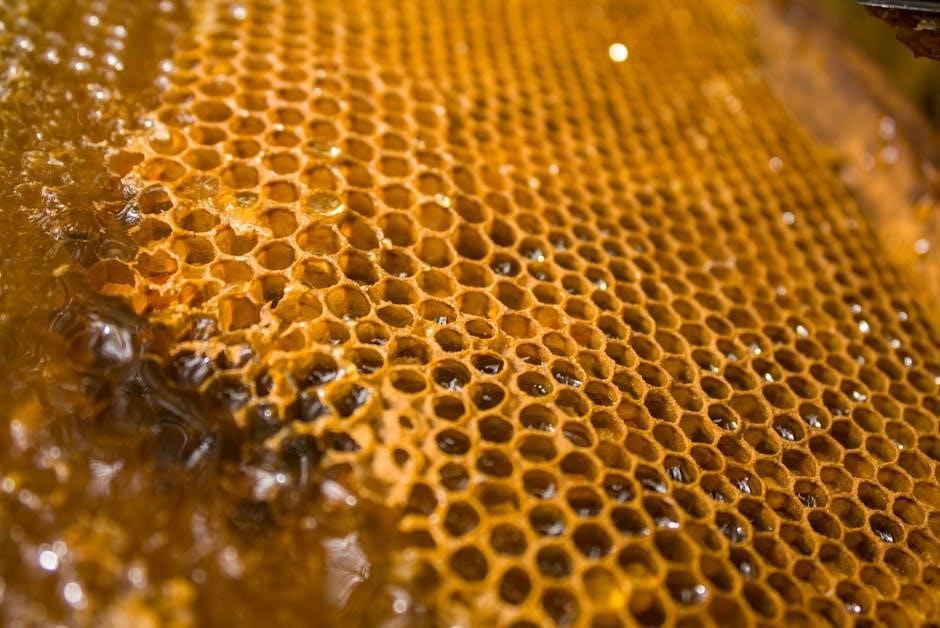The cell is a highly organized structure with specialized compartments called organelles, functioning like a factory to perform complex tasks essential for life and biological processes.
1.1 Importance of Cell Structure in Biology
The study of cell structure is fundamental to understanding life, as cells are the basic structural and functional units of all living organisms. Cells are highly organized, with specialized compartments called organelles that perform specific functions. This organization allows cells to operate efficiently, much like a factory, where different departments work together to achieve larger goals. By studying cell structure, biologists gain insights into how cells maintain homeostasis, reproduce, and respond to environmental changes. This knowledge is crucial for advancing fields like medicine, genetics, and biotechnology. Understanding cell organization also helps explain how cells adapt to specialized roles, such as nerve cells generating impulses or plant cells synthesizing nutrients. The study of cell structure underpins our understanding of life’s complexity and diversity, making it a cornerstone of biological science.
1.2 Overview of Eukaryotic Cells
Eukaryotic cells are highly advanced and organized compared to prokaryotic cells. They are characterized by the presence of a nucleus and various membrane-bound organelles, such as mitochondria, the endoplasmic reticulum, and the Golgi apparatus. These organelles are specialized to perform specific functions, allowing eukaryotic cells to achieve greater efficiency and complexity in their operations. The nucleus serves as the control center, housing the cell’s genetic material and regulating cellular activities. The cytoplasm contains the organelles and provides a medium for chemical reactions. Eukaryotic cells are found in plants, animals, fungi, and protists, and their intricate structure enables them to maintain homeostasis, grow, and reproduce effectively. This complexity makes eukaryotic cells the foundation of multicellular organisms, allowing for specialized tissues and organs to form and function.

Cell Organelles
Cell organelles are specialized structures within eukaryotic cells, each performing specific functions essential for cellular operations, such as energy production, protein synthesis, and waste management.
2.1 Structure and Function of the Nucleus
The nucleus is a membrane-bound organelle containing the cell’s genetic material. It is surrounded by a double membrane called the nuclear envelope, which regulates the movement of materials. The nucleus contains chromatin, a complex of DNA and proteins, and a nucleolus, where ribosome synthesis begins. The nucleus controls gene expression, cell growth, and reproduction by regulating the flow of genetic information to the cytoplasm. This central hub ensures the cell’s functions are coordinated according to its genetic blueprint, making it essential for life and cellular activity.

2.2 Role of Mitochondria in Cellular Energy Production
Mitochondria are often referred to as the “powerhouses” of the cell due to their critical role in energy production. These organelles generate most of the cell’s supply of adenosine triphosphate (ATP), which is used as a source of chemical energy. Mitochondria are unique in having a double membrane structure, with the inner membrane folded into cristae to increase surface area for energy production. The matrix, the innermost compartment, contains enzymes that facilitate the final stages of cellular respiration, producing ATP through oxidative phosphorylation. This process converts glucose into energy, making mitochondria indispensable for the survival and function of eukaryotic cells. Without mitochondria, cells would be unable to sustain the energy demands required for growth, repair, and maintenance of cellular activities.
2;3 Function of the Endoplasmic Reticulum
The endoplasmic reticulum (ER) is a network of membranous tubules and flattened sacs that plays a central role in several cellular processes. It is divided into two types: the rough ER and the smooth ER. The rough ER is covered with ribosomes, which synthesize proteins. These proteins are then transported through the ER’s lumen, where they are folded and modified. The smooth ER lacks ribosomes and is primarily involved in lipid synthesis, detoxification, and calcium storage. Both types of ER also function in the transport and storage of materials within the cell. Additionally, the ER works closely with other organelles, such as the Golgi apparatus, to ensure proper protein packaging and distribution. This intricate system highlights the ER’s importance in maintaining cellular organization and functionality.
2.4 Importance of the Golgi Apparatus
The Golgi apparatus is a complex organelle essential for processing, modifying, and distributing proteins and lipids within the cell. It acts as a sorting and packaging center, ensuring molecules are sent to their correct destinations. Proteins synthesized by the endoplasmic reticulum are transported to the Golgi apparatus, where they undergo further modifications, such as glycosylation, to enhance their functionality. The Golgi apparatus then packages these molecules into vesicles for delivery to lysosomes, the cell membrane, or secretion outside the cell. This organelle is critical for maintaining cellular organization and ensuring proper communication between different parts of the cell. Additionally, the Golgi apparatus plays a role in cell division by disassembling and reassembling the nuclear envelope in certain eukaryotic cells. Its functions are vital for cellular survival and functionality.

Cell Membrane and Transport
The cell membrane is a bilayer of lipid molecules, playing a crucial role in regulating the movement of substances in and out of the cell through various transport mechanisms.
3.1 Structure of the Cell Membrane
The cell membrane, also known as the plasma membrane, is a bilayer of lipid molecules with embedded proteins. This structure is essential for maintaining cellular homeostasis and controlling the movement of substances. The lipid bilayer provides a barrier, while proteins act as channels, receptors, or enzymes, facilitating interactions and transport. The fluid mosaic model describes the membrane’s dynamic nature, allowing components to move laterally. Cholesterol molecules are often embedded within the bilayer, aiding in maintaining membrane fluidity and structure. This selective permeability ensures that only specific substances enter or exit the cell, crucial for cellular function and survival. The structure of the cell membrane is vital for its role in protecting the cell and regulating its internal environment.

3.2 Passive Transport Mechanisms
Passive transport mechanisms allow substances to move across the cell membrane without requiring energy. These processes include diffusion, osmosis, and facilitated diffusion. Diffusion involves the movement of molecules from an area of higher concentration to an area of lower concentration until equilibrium is reached. Osmosis is a specific type of diffusion that refers to the movement of water molecules through a selectively permeable membrane. Facilitated diffusion uses transport proteins to help substances cross the membrane more efficiently, but it still follows the concentration gradient. These mechanisms are essential for maintaining cellular balance and ensuring the proper distribution of nutrients, gases, and waste products. They operate without the need for ATP, making them energy-efficient ways to regulate the cell’s internal environment.
3.3 Active Transport and Bulk Transport
Active transport and bulk transport are essential mechanisms for moving substances across cell membranes, requiring energy to operate against concentration gradients. Active transport involves carrier proteins that use ATP to pump ions or molecules into or out of the cell. This process is crucial for maintaining ion balance, such as in nerve and muscle cells. Bulk transport, including endocytosis and exocytosis, moves large particles like proteins or waste products. Endocytosis brings substances into the cell by forming vesicles, while exocytosis releases them outside. Both processes rely on membrane flexibility and energy expenditure. These transport methods ensure the cell can acquire necessary materials and expel waste efficiently, maintaining homeostasis and supporting various cellular functions.

Plant vs. Animal Cells
Plant cells have cell walls, chloroplasts, and large vacuoles, while animal cells lack these features but contain lysosomes and centrioles, reflecting their distinct functions and structures.
4.1 Unique Features of Plant Cells
Plant cells possess distinct structures that differentiate them from animal cells. The cell wall, composed of cellulose and pectin, provides structural support, protection, and maintains cell shape. Another unique feature is the presence of chloroplasts, which are essential for photosynthesis, enabling plants to produce their own food. Additionally, plant cells contain large vacuoles that store water, nutrients, and waste products, contributing to cell turgidity and overall plant rigidity. These specialized organelles and structures are vital for the survival and function of plant cells, distinguishing them from their animal counterparts. The organization of these components highlights the evolutionary adaptations that enable plants to thrive in their environments.
4.2 Unique Features of Animal Cells

Animal cells exhibit distinct features that set them apart from plant cells. One of the most notable is the presence of centrioles, which play a crucial role in cell division by organizing microtubules during mitosis; Additionally, animal cells contain lysosomes, membrane-bound organelles responsible for cellular digestion and recycling of macromolecules. Unlike plant cells, animal cells lack a rigid cell wall, which allows for greater flexibility and movement. The cell membrane in animal cells is more dynamic, enabling processes like endocytosis and exocytosis. Furthermore, the cytoskeleton, composed of microtubules and microfilaments, provides structural support and aids in cell motility. These features enable animal cells to adapt to various environments and perform specialized functions necessary for the survival and functionality of animal organisms. The absence of certain organelles, such as chloroplasts, further underscores their unique biological roles.

Cell Wall and Support
The cell wall provides structural support, protection, and maintains cell shape. Composed of rigid materials, it offers stability, differing in composition across organisms. Essential for prokaryotes and plant cells.
5.1 Structure and Function of the Cell Wall
The cell wall is a rigid, protective layer outside the cell membrane, primarily found in plant, bacterial, and fungal cells. It is composed of various materials depending on the organism. In plants, the cell wall is made of cellulose, hemicellulose, and pectin, providing structural support and maintaining cell shape. In bacteria, it consists of peptidoglycan, which helps withstand osmotic pressure. Fungal cell walls contain chitin or glucan. The cell wall acts as a barrier against external stress, prevents excessive water loss, and provides mechanical strength. It is essential for cell growth and division, ensuring the cell maintains its integrity and structure in varying environments. The cell wall’s composition and function are crucial for the survival and development of these organisms.
5.2 Role of the Cell Wall in Providing Support
The cell wall plays a critical role in providing structural support and maintaining the shape of the cell. It acts as a rigid layer that withstands external pressures and prevents the cell from collapsing or being deformed. In plants, the cell wall is particularly robust, enabling it to support the plant’s stature and withstand mechanical stress. Additionally, the cell wall anchors the cell membrane and provides a platform for cell growth and division. It also helps maintain cellular integrity by resisting osmotic forces, ensuring the cell does not burst or shrink excessively. This structural support is essential for the survival and proper functioning of cells, especially in multicellular organisms where cells must work together to maintain tissue and organ structure.

Cell Division and Reproduction
Cell division is essential for growth, repair, and reproduction, ensuring genetic continuity by dividing into daughter cells with identical genetic material, a fundamental process in life.
6.1 Process of Mitosis
Mitosis is a complex process of cell division resulting in two genetically identical daughter cells. It consists of several phases, including prophase, metaphase, anaphase, and telophase. During prophase, chromatin condenses into chromosomes, and the nuclear envelope dissolves. In metaphase, chromosomes align at the center of the cell, attached to spindle fibers. Anaphase involves the separation of sister chromatids, pulled to opposite poles. Finally, in telophase, nuclear envelopes reform, and chromosomes disperse. This process ensures precise distribution of genetic material, maintaining cellular continuity and enabling growth, repair, and reproduction in eukaryotic cells;
6.2 Importance of Cell Division in Growth and Repair

Cell division is a fundamental biological process essential for growth, development, and tissue repair. It allows organisms to replace damaged or dead cells, maintaining tissue integrity and overall health. During development, cell division enables the formation of specialized cells, contributing to the growth of organs and tissues. In adulthood, it facilitates wound healing and regeneration by replenishing cells lost due to injury or disease. Additionally, cell division is crucial for immune function, as it generates new immune cells to combat pathogens. This process ensures genetic continuity, producing daughter cells genetically identical to the parent cell. Understanding cell division is vital for appreciating how life sustains and adapts, making it a cornerstone of biological study and medical advancements in regenerative and cancer therapies.
